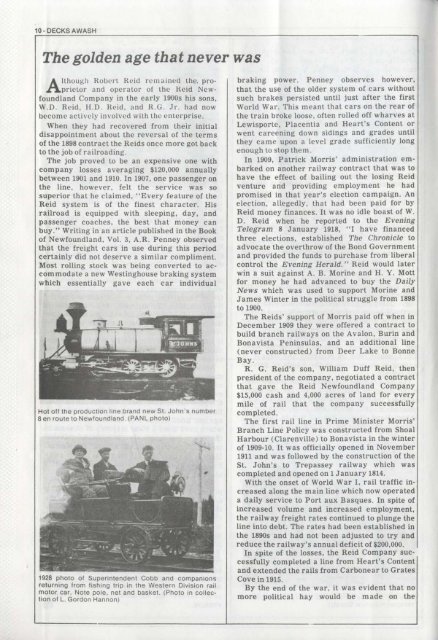OlCKSavvash - Memorial University of Newfoundland
OlCKSavvash - Memorial University of Newfoundland
OlCKSavvash - Memorial University of Newfoundland
Create successful ePaper yourself
Turn your PDF publications into a flip-book with our unique Google optimized e-Paper software.
10 - DECKS AWASH<br />
The golden age that never was<br />
lthough Robert Heid remained the. pro<br />
A prietor and operator <strong>of</strong> the Reid <strong>Newfoundland</strong><br />
Company in the early 1900s his sons,<br />
W.O. Reid, H.D. Heid, and H..G. Jr. had now<br />
become actively involved with the enterprise.<br />
When they had recovered from their initial<br />
disapPointment about the reversal <strong>of</strong> the terms<br />
<strong>of</strong> the 1898 contract the Reids once more got back<br />
to the job <strong>of</strong> railroading.<br />
The job proved to be an expensive one with<br />
company losses averaging $120,000 annually<br />
between 1901 and 1910. In 1907, one passenger on<br />
the line, however, felt the service was so<br />
superior that he claimed, "Every feature <strong>of</strong> the<br />
Reid system is <strong>of</strong> the finest character. His<br />
railroad is equipped with sleeping, day, and<br />
passenger coaches, the best that money can<br />
buy." Writing in an article pUblished in the Book<br />
<strong>of</strong> <strong>Newfoundland</strong>, Vol. 3, A.H. Penney observed<br />
that the freight cars in use during this period<br />
certainly did not deserve a similar compliment.<br />
Most rolling stock was being converted to accommodate<br />
a new Westinghouse braking system<br />
which essentially gave each car individual<br />
Hot <strong>of</strong>f the production hne brand new St. John's number<br />
8 en route to <strong>Newfoundland</strong>. (PANl photo)<br />
1928 photo <strong>of</strong> Superintendent Cobb and companion'><br />
returning from fishing triP in the Western DIvision rail<br />
motor car. Note pole, net and basket. (Photo in collection<br />
<strong>of</strong> l. Gordon Hannon)<br />
braking power. Penney observes however,<br />
that the use <strong>of</strong> the older system <strong>of</strong> cars without<br />
such brakes persisted until just after the first<br />
World War. This meant that cars on the rear <strong>of</strong><br />
the train broke loose, <strong>of</strong>ten rolled <strong>of</strong>f wharves at<br />
Lewisporte, Placentia and Heart'S Content or<br />
went careening down sidings and grades until<br />
they came upon a level grade sufficiently long<br />
enough to stop them.<br />
In 1909, Patrick Morris' administration embarked<br />
on another railway contract that was to<br />
have the effect <strong>of</strong> bailing out the losing Reid<br />
venture and providing employment he had<br />
promised in that year's election campaign. An<br />
election, allegedly, that had been paid for by<br />
Reid money finances. It was no idle boast <strong>of</strong> W.<br />
D. Reid when he reported to the Evening<br />
Telegram 8 January 1918, "I have financed<br />
three elections, established The Chronicle to<br />
advocate the overthrow <strong>of</strong> the Bond Government<br />
and provided the funds to purchase from liberal<br />
control the Evening Herald." Reid would later<br />
win a suit against A. B. Morine and H. Y. Mott<br />
for money he had advanced to buy the DaUy<br />
News which was used to support Morine and<br />
James Winter in the political struggle from 1898<br />
to 1900.<br />
The Reids' support <strong>of</strong> Morris paid <strong>of</strong>f when in<br />
December 1909 they were <strong>of</strong>fered a contract to<br />
build branch railways on the Avalon, Burin and<br />
Bonavista Peninsulas, and an additional line<br />
(never constructed) from Deer Lake to Bonne<br />
Bay.<br />
R. G. Reid's son, William Duff Reid, then<br />
president <strong>of</strong> the company, negotiated a contract<br />
that gave the Reid <strong>Newfoundland</strong> Company<br />
$15,000 cash and 4,000 acres <strong>of</strong> land for every<br />
mile <strong>of</strong> rail that the company successfully<br />
completed.<br />
The first rail line in Prime Minister Morris'<br />
Branch Line Policy was constructed from Shoal<br />
Harbour (Clarenville) to Bonavista in the winter<br />
<strong>of</strong> 1909-10. It was <strong>of</strong>ficially opened in November<br />
1911 and was followed by the construction <strong>of</strong> the<br />
St. John's to Trepassey railway which was<br />
completed and opened on 1 January 1814.<br />
With the onset <strong>of</strong> World War I, rail traffic increased<br />
along the main line which now operated<br />
a daily service to Port aux Basques. In spite <strong>of</strong><br />
increased volume and increased employment,<br />
the railway freight rates continued to plunge the<br />
line into debt. The rates had been established in<br />
the 1890s and had not been adjusted to try and<br />
reduce the railway's annual deficit <strong>of</strong> $200,000.<br />
In spite <strong>of</strong> the losses, the Reid Company successfully<br />
completed a line from Heart's Content<br />
and extended the rails from Carbonear to Grates<br />
Cove in 1915.<br />
By the end <strong>of</strong> the war, it was evident that no<br />
more political hay would be made on the

















